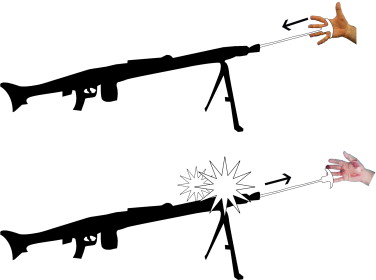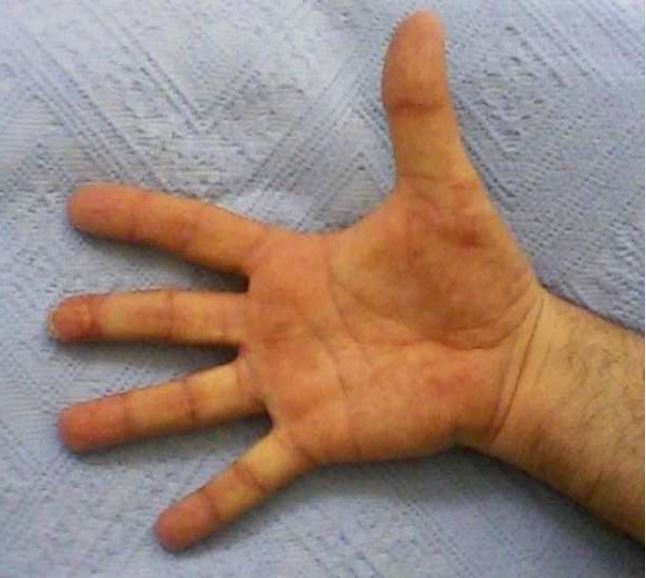Gun-cleaning accidents
Case report
A 35 year–old man was admitted to emergency department with a complaint of injury related to the third web space, third finger pulp and thenar region of right hand. On detailed questioning, he reported that he was cleaning a machine gun (type MG-3) after target practice in a shooting range. He didn’t check visually and physically whether there were any bullets or not in the chamber. The remaining bullet in the chamber was ignited during the cleaning process when he pushed the rod through the barrel (Figure 1). In the physical examination, on his right hand, there were 1.5×1.5 cm full thickness skin defect on pulp of the third finger accompanying bone exposition on ground, 3×2.5 cm full thickness skin defect on thenar region, 1 cm depth laceration on third web space from volar to dorsal and multiple superficial lacerations on volar region (Figure 2). All digits were well perfused. Neurological findings and motor functions of all digits were within normal range. There was no fracture on X-ray. All of the wounds were washed with antimicrobial solution (11). Lacerations relevant to the third web space, hypothenar region and the other multiple small lacerations of the hand were sutured and the defect of soft tissue of the thenar region was covered with full thickness skin graft prepared from the severed skin of pulp (Figure 3). Cast immobilization was applied and intravenous prophylactic antibiotic was administered postoperatively. All of the wounds were healed on postoperative 15th day and he proceeded to physiotherapy program after the sutures removed. Patient were seen in outpatient clinic in every month for 12 months. To prevent development of hypertrophic scar, pomade including silicone (Dermatix® Silicone Gel) was prescribed (12-13). At the end of the follow-up period we not encountered any hypertrophic scar development in both primer sutured and grafted areas. Active and passive range of motion for all fingers was fully achived followed by physiotherapy program (Figure 4). Patient had fully satisfied with good functionality of his dominant hand in his daily life and job activity.


Figure 2

Figure 3

Abdul Kerim Yapici, M.D. Department of Plastic and Reconstructive Surgery, Gulhane Military Medical Academy, Ankara/Turkey Phone: +90 312 304 5408 Fax: +90 312 304 5404
E-mail: dryapici@hotmail.com
1. Eber GB, Annest JL, Mercy JA, Ryan GW. Nonfatal and fatal firearm-related injuries among children aged 14 years and younger: United States, 1993-2000. Pediatrics. 2004;113:1686-92. 2. Chapdelaine A, Samson E, Kimberley MD, Viau L. Firearm-related injuries in Canada: issues for prevention. CMAJ. 1991;145:1217-23. 3. Karger B, Billeb E, Koops E. Accidental firearm fatalities. Forensic and preventive implications. Int J Legal Med. 2002;116:350-3. 4. Langley JD, Marshall SW, Norton RN. Nonfatal firearm injuries in New Zealand, 1979-1992. Ann Emerg Med. 1996;28:170-5. 5. Pereira C, Boyd JB, Olsavsky A, Gelfand M, Putnam B. Outcomes of complex gunshot wounds to the hand and wrist: a 10-year level I urban trauma center experience. Ann Plast Surg. 2012;68:374-7. 6. Rodrigues RL, Sammer DM, Chung KC. Treatment of complex below-theelbow gunshot wounds. Ann Plast Surg. 2006;56:122-7. 7. Dicpinigaitis PA, Koval KJ, Tejwani NC, Egol KA. Gunshot wounds to the extremities. Bull NYU Hosp Jt Dis. 2006;64:139-55. 8. Wilson RH. Gunshots to the hand and upper extremity. Clin Orthop Relat Res. 2003; 408:133-44. 9. http://www.wikihow.com/Maintain-a-Pistol-(Handgun). (Accessed date: 04, 04 2013) Page 9 of 14 Accepted Manuscript 9 10. http://en.wikipedia.org/wiki/Rheinmetall_MG3#External_links (Accessed date: 05, 04 2013) 11. Walker SR, Anderson T. A Study of Methods Used to Reduce Surgical Site Infections. Arch Clin Exp Surg. 2012; 1(1): 27-33. 12. Karagoz H, Sever C, Bayram Y, Sahin C, Kulahci Y, Ulkur E. A Review of the Prevention and Treatment of Hypertrophic Scars: Part I Clinical Aspects. Arch Clin Exp Surg. 2012; 1(4): 237-248. 13. Karagoz H, Bayram Y, Sever C, Sahin C, Kulahci Y, Ulkur E. A Review of the Prevention and Treatment of Hypertrophic Scars: Part II. Experimental Studies. Arch Clin Exp Surg. 2013; 2(1): 49-58. 14. http://www.kleen-bore.com/safetytips.html (Accessed date: 05, 04 2013) 15. Vincent J. M. Di Maio, Gunshot Wounds: Practical Aspects of Firearms, Ballistics, and Forensic Techniques. Firearms and Ammunition. 1999. 1. Eber GB, Annest JL, Mercy JA, Ryan GW. Nonfatal and fatal firearm-related injuries among children aged 14 years and younger: United States, 1993-2000. Pediatrics. 2004;113:1686-92. 2. Chapdelaine A, Samson E, Kimberley MD, Viau L. Firearm-related injuries in Canada: issues for prevention. CMAJ. 1991;145:1217-23. 3. Karger B, Billeb E, Koops E. Accidental firearm fatalities. Forensic and preventive implications. Int J Legal Med. 2002;116:350-3. 4. Langley JD, Marshall SW, Norton RN. Nonfatal firearm injuries in New Zealand, 1979-1992. Ann Emerg Med. 1996;28:170-5. 5. Pereira C, Boyd JB, Olsavsky A, Gelfand M, Putnam B. Outcomes of complex gunshot wounds to the hand and wrist: a 10-year level I urban trauma center experience. Ann Plast Surg. 2012;68:374-7. 6. Rodrigues RL, Sammer DM, Chung KC. Treatment of complex below-theelbow gunshot wounds. Ann Plast Surg. 2006;56:122-7. 7. Dicpinigaitis PA, Koval KJ, Tejwani NC, Egol KA. Gunshot wounds to the extremities. Bull NYU Hosp Jt Dis. 2006;64:139-55. 8. Wilson RH. Gunshots to the hand and upper extremity. Clin Orthop Relat Res. 2003; 408:133-44. 9. http://www.wikihow.com/Maintain-a-Pistol-(Handgun). (Accessed date: 04, 04 2013) Page 9 of 14 Accepted Manuscript 9 10. http://en.wikipedia.org/wiki/Rheinmetall_MG3#External_links (Accessed date: 05, 04 2013) 11. Walker SR, Anderson T. A Study of Methods Used to Reduce Surgical Site Infections. Arch Clin Exp Surg. 2012; 1(1): 27-33. 12. Karagoz H, Sever C, Bayram Y, Sahin C, Kulahci Y, Ulkur E. A Review of the Prevention and Treatment of Hypertrophic Scars: Part I Clinical Aspects. Arch Clin Exp Surg. 2012; 1(4): 237-248. 13. Karagoz H, Bayram Y, Sever C, Sahin C, Kulahci Y, Ulkur E. A Review of the Prevention and Treatment of Hypertrophic Scars: Part II. Experimental Studies. Arch Clin Exp Surg. 2013; 2(1): 49-58. 14. http://www.kleen-bore.com/safetytips.html (Accessed date: 05, 04 2013) 15. Vincent J. M. Di Maio, Gunshot Wounds: Practical Aspects of Firearms, Ballistics, and Forensic Techniques. Firearms and Ammunition. 1999.